The term “superabundance” can be identified as particularly apt when looking at the reality of today. Narratives, ideologies, machines and, more generally, objects now define an oceanic cacophony within which the boundaries of the human being are becoming increasingly thin and blurred. That “horror pleni” theorised by Gillo Dorfles in 2008 has now taken on unspeakable proportions and such that the meaning of one’s existence is being profoundly questioned. Boundaries are fading and stretching to such an extent as to inhibit any capacity for self-definition. What it means to be “human” and how one differs from this “other” therefore remain unresolved questions and vast terrain for research.

Hyoju Cheon, “Siding with things”, installation view at subtitled nyc, Brooklyn, New York, 17/06 – 9/07/2023, photo credit: Yulin Gu, courtesy the artist
It is along these lines that the practice of Hyoju Cheon (1994, Seoul, lives and works in New York), an artist whose investigations embrace a broad expressive spectrum ranging from performance to sculpture to drawing and writing, can be framed. Looking at the fledgling energy of her work, it is possible to identify two main thematic lines. The first concerns the dimension of the body from the perspective of putting individual corporeity and its reactions to the surrounding reality back at the centre. In this sense, there is a sort of anthropological propensity to investigate how the individual reacts to the stimuli from the outside world, finding preliminary confirmation in her opening interview: «While on the road, the child spotted a random structure and spontaneously rolled her toy car over it. It was incredible to witness how quickly and instinctively they react to their surroundings. This moment makes me want to make “siding with things,” intuitive movement between object/structure and subject». The second aspect, on the other hand, refers to an equally vast investigation field which, especially since the 1990s, has seen a multiplicity of artists decide to go beyond the centrality (and authorship) of the subject to probe new expressive potentialities having as their epicentre, instead, the value of the object. In Cheon’s practice, one glimpses a very definite awareness of the importance that, today, ‘things’ have for the individual. In the wake of an approach to consumerism that is increasingly becoming a structuring element of our existences, there is no doubt that objects influence and shape the present by acting as true founding components of the answers to questions such as “Who are we? What do we do?”.
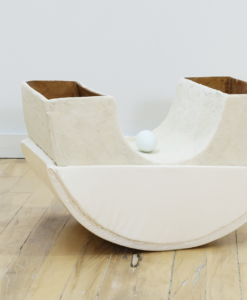
Hyoju Cheon, “Toomm Ta”, H 12 inch x L 18.5inch x W 13 inch , wood, servo motor, egg, polyester fabric, foam, courtesy the artist
Theirs is a silent influence, proceeding on tiptoe but at the same time utterly devastating in the dynamics of individual definition. In 1989, Robert Gober explained: «[…] For the most part, the objects that I choose are almost all emblems of transition; they’re objects that you complete with your body, and they’re objects that, in one way or another, transform you. Like the sink, from dirty to clean; the beds, from conscious to unconscious; rational thought to dreaming; the doors transform you in the sense that you were speaking of, moving from one space through another […]» . Knowing how to put such a scenario in the spotlight – knowing how to isolate and study it from the outside – is essential for the development of a new awareness and thus way of life. Something that emerges from the installation character of “siding with things” (2023). As the artist explained: «It’s about intuitive movement and sound, mirroring children’s spontaneous noises. Sculptures emerge from the space’s architecture, aligning with walls, ceilings, and floors. This immersive environment engages the senses, inviting exploration, reflection on how we interact with our surroundings, and how these interactions are integral to our understanding and appreciation of space».

Hyoju Cheon,, “Unnecessary things we carry, Homo-motus”, 2019, drawing on graph paper casting plaster, clay, dimension variable, performance 15 min, photo credit: Soojeong Kim, courtesy the artist
There is, therefore, within her practice a pulsating will to offer an alternative vision of reality, fuelling her own creative vitality of continuous questioning. Living in and having experienced global metropolises such as Seoul first and New York now, where, in her opinion, concepts such as competition, productivity or the directing of any kind of behaviour towards the utilitarian achievement of goals that find their raison d’être in the face of material satisfaction, has drastically influenced her artistic research: «And what is productive means? Why only meaningful behavior has meaning? My thought is meaningless behavior (sometimes we call it unproductive) also has a meaning in different ways». From 2019, therefore, she began to develop works that focus on this exaltation of the useless, of the discarded, of the no-sense as the last vestiges of that individual freedom of choice that differentiates us from the mechanical world. All of this takes the form of a sort of thematisation of the entirely sharable idea that, as humans, we are much more than what we do.
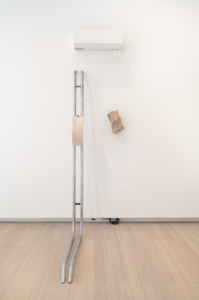
Hyoju Cheon, “How can we measure our sigh?”, photo credit: Kunning Huang
2022, steel pipe, paper bag, pulley system, wooden block, 104 inch x 7 inch dimension variable, courtesy the artist
It is therefore on this premise that her “Unnecessary things we carry, Homo-motus” (2019) is structured: «“Homo-motus” is exhibited in the form of performance and archiving. This work fossilizes traces of the meaningless and inefficient movements in Korean society by casting the performance’s traces on the clay. This work began with the question of what the artist’s role was in this era and extended to the question of humans. In the future, where AI dominates, can human inefficiencies and nonsense be more meaningful? That’s why I thought I/we should record and collect the things that we always tend to forget. At that time, I thought that what we need to preserve is our everyday life. So, I’ve been working on transforming daily activities into new scenes or visual language». On this line we find also “About movement” (2019), a cumbersome and completely useless system that has no purpose other than movement itself whose only testimony and aesthetic value is the mark left by the pencil. Again, Cheon decides to go beyond any utilitarian logic by focusing instead on something that has no other reason for being than its existence. There is therefore a clear awareness of the desire to elevate those waste residual elements of our living to an artistic dimension, starting from what remains of the movements up to the materialisation of the sounds heard from time to time (“The sound I draw”, 2021) captured through the creative immediacy of drawing.
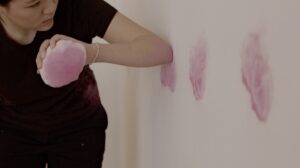
Hyoju Cheon, “Mapping without scale”, 2022, insulation foam, wall compound, ceramic, dimension variable, performance duration 16min, photo credit: Ryan Wang, courtesy the artist
All of this is centred on the performative act as an essential tool for connecting the concepts of body, object and space: «The relationship between those three elements – body, object and space – becomes clear through movement and performance. Whether it’s my performance or that of a machine, I view the residues left after any movement as essential elements in creating my work. I replicate the small movements and sounds that occur in daily life. This volatility is precisely why I feel compelled to perform». “Mapping without scale” (2022), a site-specific project presented at Iron Velvet in New York, fully synthesises the interconnection between these elements. As she explained, there was a complete abandonment of the classical tools for measuring space, leaving instead one’s own body to read it in a more immediate, spontaneous and individual manner. Focusing then on those more shadowed areas, such as corners or crevices, she gave life by drawing abstract and amorphous forms that could inhabit them. Cheon then recreated them three-dimensionally using clay or insulating foam, imprinting the shapes of her own body on these objects, which, fired and sculpted, succeeded in capturing those voids. There is thus a refusal to submit to an experience of space mediated by the more conventional instruments of measurement in favour, instead, of an individual and direct interpretation mode. This idea of movement as an instrument of “deconstruction” can also be found in her “Trajectory of my body” (2021), a performance conceived during the COVID period between 2020 and 2021, in which she engaged in a continuous repetition of simple and banal gestures, taking them to the point of absurdity. The everyday becomes a performative matter with a view to becoming aware of the underlying automatisms, norms and social constraints as obstacles to a different experiential modality. She argues in fact: «The performance becomes a symbolic journey, turning mundane into significant, reflecting on how energy flows and interacts in different spaces and situations».
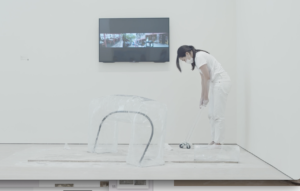
Hyoju Cheon, “Trajectory of my body”, 2021, plywood, sand, vinyl, rubber pipe, plastic rod and wheel, dimension variable, performance 20 min, photo credit: Ryan Wang, courtesy the artist
Returning to the more direct interpenetration between individual and object, in “How can we measure our sigh” (2022) the acts of inhaling and exhaling are translated into a mechanical vocabulary in a bidirectional key: the individual becoming machine and the machine becoming human. Inspired by a friend’s joking assertion during a break from studying, such that the more effort and time he spent the greater the condensation of his breath in the cold, Cheon began to wonder how she could try her hand at measuring unquantifiable acts. For “How can we measure our sigh”, she devised a mechanical system with which she alternates downwards and upwards the movement of a heavy block of wood and a paper bag, generating a visual paradox whereby the lightness of the latter manages to balance the weight of the former. Emulating the rhythm of breathing, the installation refers to the complexity linked to the measurement of work and individual effort. Again, an attempt to highlight the ambiguity connected to the conception of standardised quantification systems that inevitably influence the subjective sphere and its approach to the surrounding reality. Through this character of multimedia openness and constant reflection on the potential of interaction between objects, body and space, Cheon thus aims to shake up the “how” the now anaesthetised individual capacities of investigation are applied to the interpretation of the everyday. A desire further reinforced by a sense of pragmatism in approaching her reflections rooted in a certain kind of experience that averts the risk of the work becoming entangled in the tangles of the most predictable ideological utopia.
[1] (https://bombmagazine.org/articles/robert-gober/).
Info:
Hyoju Cheon (1994) holds an MFA from the Colombia University, New York and is now part of the NARS Foundation residency programme. The most recent solo-shows includes Memory Mirage, Kunstraum LLC, Brooklyn, USA (2023), Siding with things, Subtitled nyc, Brooklyn, USA (2023), CV exhibition, Hello artists, Busan, Korea (2023), Lighting, Tapiial Virtual gallery, Chile (2023), Flow – out, CLEA RSKY Coxsackie West, New York, USA (2022), OTHERWISE, curated by Victoria, Howon Kim and Carlora, Half gallery, New York, USA (2022), Hyoju Cheon: Mapping without scale, curated by Howon Kim, Iron Velvet, New York, USA (2022). Among the group-shows 공동프로젝트, Project Broom, Seoul, Korea (2019), Five (un)necessary things that we are carrying, Dongsomun, Seoul, Korea, OH MY HOMETOWN _ from ! ’, 미아리고개 하부공간 미인도, meindo, Seoul, Korea (2019). In 2023 she was selected for the residency at Kunstraum LLC, Brooklyn, USA.
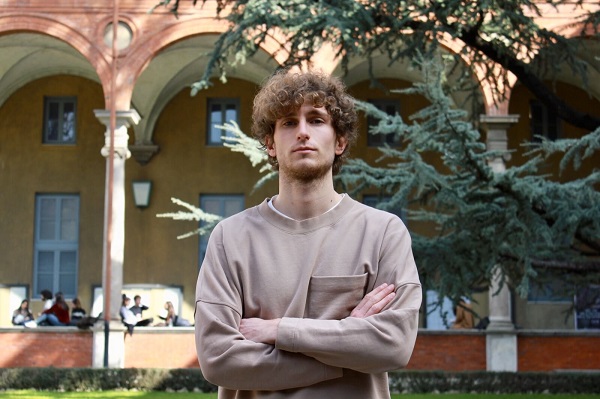
With a specialist degree in Economics and Management of Cultural Heritage, passionate about the field of Contemporary art, its economic dimension and, more generally, the dynamics characterizing the art market, Gabriele has gained experience over time in contexts such as contemporary art galleries, start-ups and Art Advisory. He currently works in the Art-Rite auction house as an assistant in the department of Modern and Contemporary art.






NO COMMENT